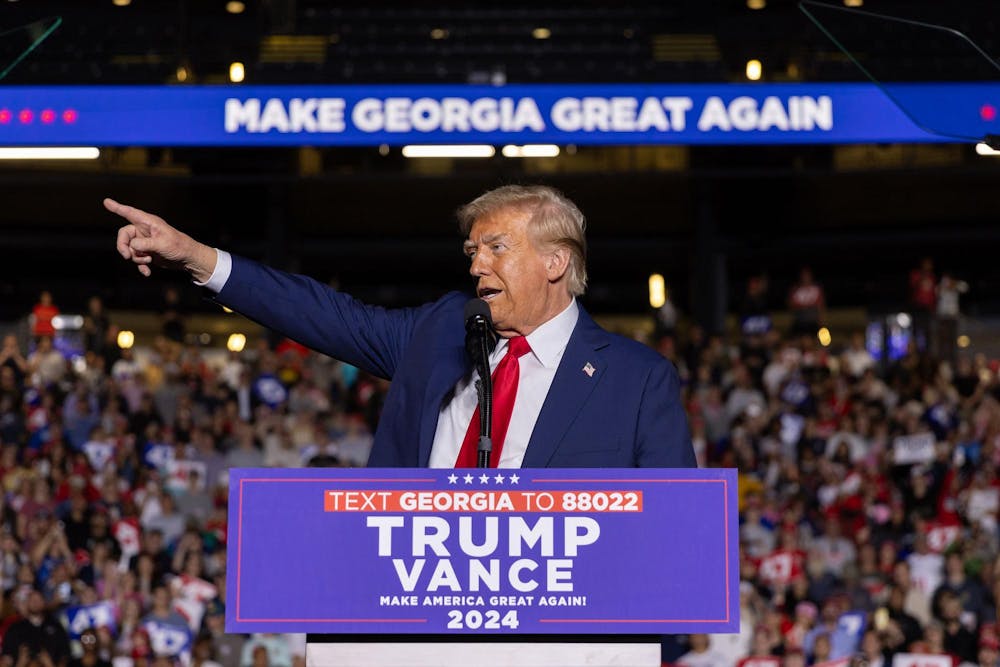Former President Donald Trump has made vast claims about how he would improve the American economy if elected to a second presidential term in 2024. Imposing increased, sweeping tariffs is a cornerstone of Trump’s economic agenda.
At an economic forum with Bloomberg News Editor-in-Chief John Micklethwait, Trump said, “To me the most beautiful word in the dictionary is tariff. It’s my favorite word.”
A tariff is a tax imposed on imported goods. Tariffs are often used in the United States to protect domestic industries by deterring companies from outsourcing from foreign countries. High tariffs, however, have become controversial due to their ability to reduce trade, generate hostility between countries and increase inflation. Tariffs are imposed by nearly all countries, but wealthy countries tend to charge lower tariffs than developing countries.
During his candidacy, Trump proposed a protectionist trade policy including a universal tariff of 10-20% on all imports into the U.S. as well as a tariff of 60% on all imports from China.
He argues imposing such tariffs would foster job growth, shrink the federal deficit, decrease consumer prices and benefit domestic businesses.
He proposed using the potential revenue from heightened tariffs to fund a wide range of policy proposals, from childcare to tax cuts.
A controversial side effect of increasing tariffs so drastically is potential retaliation from the impacted countries, particularly China. Implementing such high tariffs could lead to increasingly tense foreign relations or even a trade war, some economists say.
During Trump’s last term, his administration imposed a targeted 25% tariff on $34 billion of Chinese imports. This decision led to a trade war between the U.S. and China in which China responded to Trump’s tariffs by imposing the same taxes on American imports.
Mostafa Beshkar, an associate professor of economics at IU with a specialization in international trade and trade policy, said the likelihood of countries not retaliating in trade disputes is near zero.
“These tariffs are negotiated,” Beshkar said. “So, the reason U.S. tariffs on global imports are generally low is because it was negotiated that other countries would reduce their tariffs and the U.S. would reduce its tariffs.”
Mark Cuban, billionaire businessman and IU alumnus, agreed.
“There are always retaliatory tariffs,” Cuban wrote in an email to the Indiana Daily Student. “If you look at the retaliation by China during Trump’s term, you will see they got the best of us.”
Worsened inflation of the prices of goods for U.S. consumers is likely to come with heightened tariffs. Despite popular belief, the importer of a product nearly always pays the tariff, not the exporting country. As a result, the importing country’s prices must rise to make up for the cost of the tariff.
“When they (businesses) pass on those costs to consumers, that means consumers can buy less of what they need and retailers can sell less of what they need to sell to be profitable,” Cuban wrote.
A report from the Peterson Institute for International Economics shows inflation under a second Trump presidency could hit a high of 9.3% by 2026. The baseline estimate for inflation without Trump’s policies is 1.9%. With such inflation, the institute estimates an average household could face $2,600 in increased costs per year. Other estimates suggest costs could reach as high as an extra $7,600 per year.
In response to this, Vice President and Democratic presidential opponent Kamala Harris called Trump’s tariff plan a “sales tax on the American people.”
Because Indiana is a major exporter of goods, it could be hit harder by these policies than other states. According to the Office of the United States Trade Representative, Indiana was the ninth-largest exporter of goods out of all U.S. states in 2023. In 2021, Indiana exports supported an estimated 173,000 jobs.
Trump even suggested replacing income taxes with trade taxes.
“He has this idea that when you impose a tax on imports, it’s paid for by foreigners,” Beshkar said.
However, economists say consumers generally end up paying the majority of these costs as they are passed on from importers.
Only 2% of the federal government’s tax income is made up of tariff revenues, and 15% of the U.S. GDP represents imports. Beshkar said significantly increasing revenue solely by raising tariffs is unlikely.
Part of Trump’s argument for high tariffs is the protection of domestic jobs and American workers while expanding the job market.
However, the Tax Foundation, a nonpartisan tax policy nonprofit, estimated the loss of 684,000 full-time equivalent jobs in the U.S. if Trump imposes his proposed tariff plan. While some jobs may be gained, Beshkar said the loss of employment typically outweighs the growth.
As for more job growth in the U.S., Cuban referenced Trump’s past term.
“Trump started his trade war in 2018,” Cuban wrote. “By the time it pretty much ended two years later, there was no evidence of companies coming back.”
One of the largest impacts of tariffs would be a decrease in productivity, Beshkar said. If achieved, Trump’s goal of cutting off outsourcing would force the U.S. to produce items that are more commonly produced by other countries, driving down efficiency.
While a trade war could be costly for Americans, Beshkar said, the U.S. may have something to gain from renegotiating current trade agreements.
“Historically, the U.S. has given more trade concessions to the rest of the world than the rest of the world has given to the U.S.,” Beshkar said. “So, the U.S. is in a strong bargaining position with the rest of the world to negotiate these terms.”




